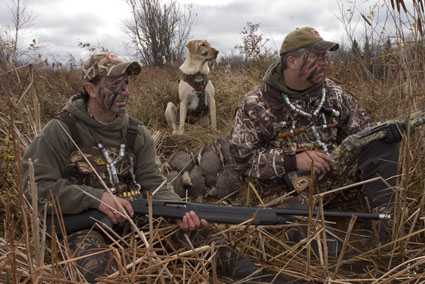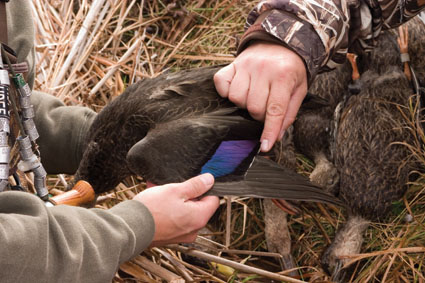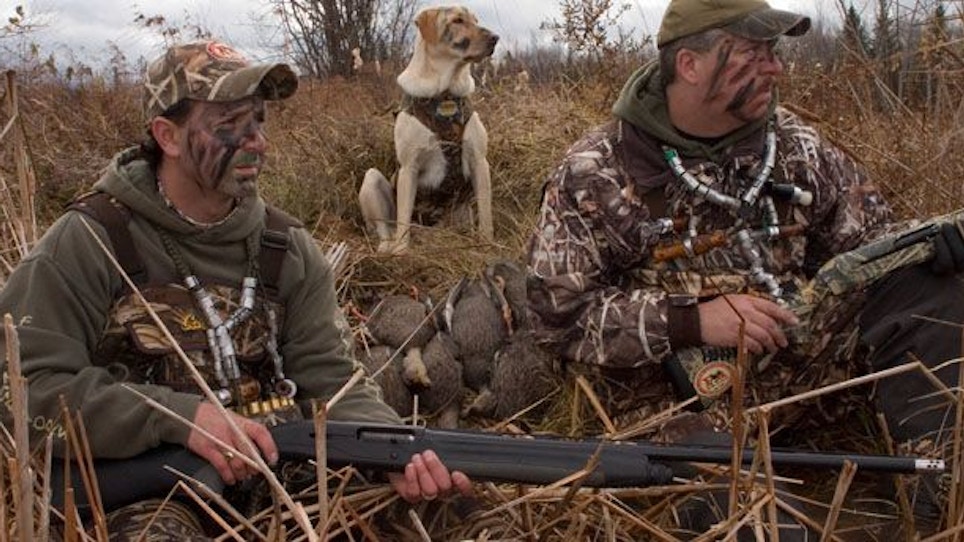 Squinting across the marsh into the black clouds, I manage to close the gaping neck of my oversized rain jacket with one hand and pull the two drawstrings tight. My right hand grips a Remington 11-87. I stiffly twist my upper body, head down, toward the horizontal rain and howling wind until the stinging droplets force me to turn my back to the storm again. The borrowed raincoat must be held closed, which renders my left hand useless, but it is still better than nothing against the first bands of Hurricane Noel funneling up the Bay of Fundy.
Squinting across the marsh into the black clouds, I manage to close the gaping neck of my oversized rain jacket with one hand and pull the two drawstrings tight. My right hand grips a Remington 11-87. I stiffly twist my upper body, head down, toward the horizontal rain and howling wind until the stinging droplets force me to turn my back to the storm again. The borrowed raincoat must be held closed, which renders my left hand useless, but it is still better than nothing against the first bands of Hurricane Noel funneling up the Bay of Fundy.
I look into the lashing storm, scanning the low-hanging sky for a glimpse of a struggling black duck in the wind. Nothing. I turn my back and sink behind the earthen dyke to take a break from the blinding rain and wind. To my right, Curtis, the hunting guide, is lighting a Canadian cigarette in the only dry spot on the marsh — the square-foot area under the hood of his raincoat. I shake my head in disbelief.
Then a voice yells above the wind, “This is what we mean when we say ‘no days off!’ ” That voice belongs to John Vaca. I wonder, “do I wait until I make it out of here alive before I thank him for inviting me into the Shepody Marsh, on an incoming tide, during a hurricane, to shoot ducks?”
Other than our waders and rain jackets, the only other protection we have from the storm is the 8-foot-tall dyke covered in marsh grass. I have a hard time believing that in the early 1700s the Acadians (many of whom were later forced from Canada by the British during the Great Expulsion of 1755 and would go on to become known as the Cajuns that populated Louisiana) who built this amazing structure could have foreseen that it would be used as a duck blind and shield for three crazy duck hunters in a downpour. Still, I’m thankful that the Acadians built the dyke to hold back the twice-daily tidal rush of salt water, which preserved the fertile marsh that they farmed. Now, 300 years later, we’re using it to ambush black ducks.
A quarter-mile away, thousands of black ducks are visible flying back and forth through the marsh, but none are headed in our direction. Then, suddenly, two black ducks streak over our heads from behind. Vaca mans the calls and blows loudly to the disappearing birds. Amazingly, they bank hard into the wind, swing wide, and turn in our direction. Peering through the marsh grass, I watch as the blacks turn sharply and parallel the dyke right in front of us. As they catch the tailwind and begin to angle away, my first shot sends one crumpling to the ground. I miss my second shot and think, “there’s no way I can make the shot now, but it’s almost dark and I’d better make the best of this miserable hunt.” Boom! For a split second nothing happens, and then the other black duck folds up and falls into the marsh.
How It’s Done In The Maritimes
 With regard to hunting black ducks, one word comes to mind: “detail.” Every aspect of the hunt is detail-oriented. Calling, decoy spreads, camouflage and location all must be thoroughly planned and every detail addressed. Successful hunters are anal-retentive to a fault, but at the end of the day their decoy-filled trucks usually are hauling limits of the cautious birds.
With regard to hunting black ducks, one word comes to mind: “detail.” Every aspect of the hunt is detail-oriented. Calling, decoy spreads, camouflage and location all must be thoroughly planned and every detail addressed. Successful hunters are anal-retentive to a fault, but at the end of the day their decoy-filled trucks usually are hauling limits of the cautious birds.
Decoy spreads must be set up just so to lure in the large dabblers. The theory — no, make that gospel — is that if something looks artificial or out of place, the ducks will head for another feeding ground.
“It’s very easy to over-decoy a pond,” explains Darren Hasson of New Brunswick. “Black ducks are not traffic birds — you have to be where they want to be. These birds are more private and not as sociable as mallards.”
Hasson is a waterfowl outfitter in New Brunswick who specializes in black-duck hunting. Hasson and his crew cover most of the province, though during my trip, we chased black ducks, mallards and Canada geese across New Brunswick and into Nova Scotia. We covered a lot of ground, but we were always shooting a bunch of birds. This is one of Hasson’s secrets for limiting out on black ducks consistently — he never over-hunts a spot and the birds are always fresh.
When Hasson lays out his spread for black ducks, he only uses eight to 12 decoys, along with a pair of Canada geese decoys.
“I call this my Section 8 spread,” says Hasson. “In the military, when a soldier is discharged for being crazy, it’s called Section 8. Like the classification, it’s crazy what this spread of eight will do on black ducks.”
The Canada decoys are used as a confidence booster for the birds. Because black ducks are commonly found among feeding geese, they feel safer when geese are in the spread. The spread also will work to pull in geese, which are abundant throughout much of New Brunswick. Hasson sets up the black-duck decoys to the side of his layout blinds. So the incoming birds’ attention is not focused on the camouflaged hunters.
The 27-year-waterfowl veteran once used only cork decoys because they were the most realistic-looking, but he has been experimenting with Final Approach (FA) black-duck decoys and has found that they work extremely well, too.
Stay tuned for Part 2!






